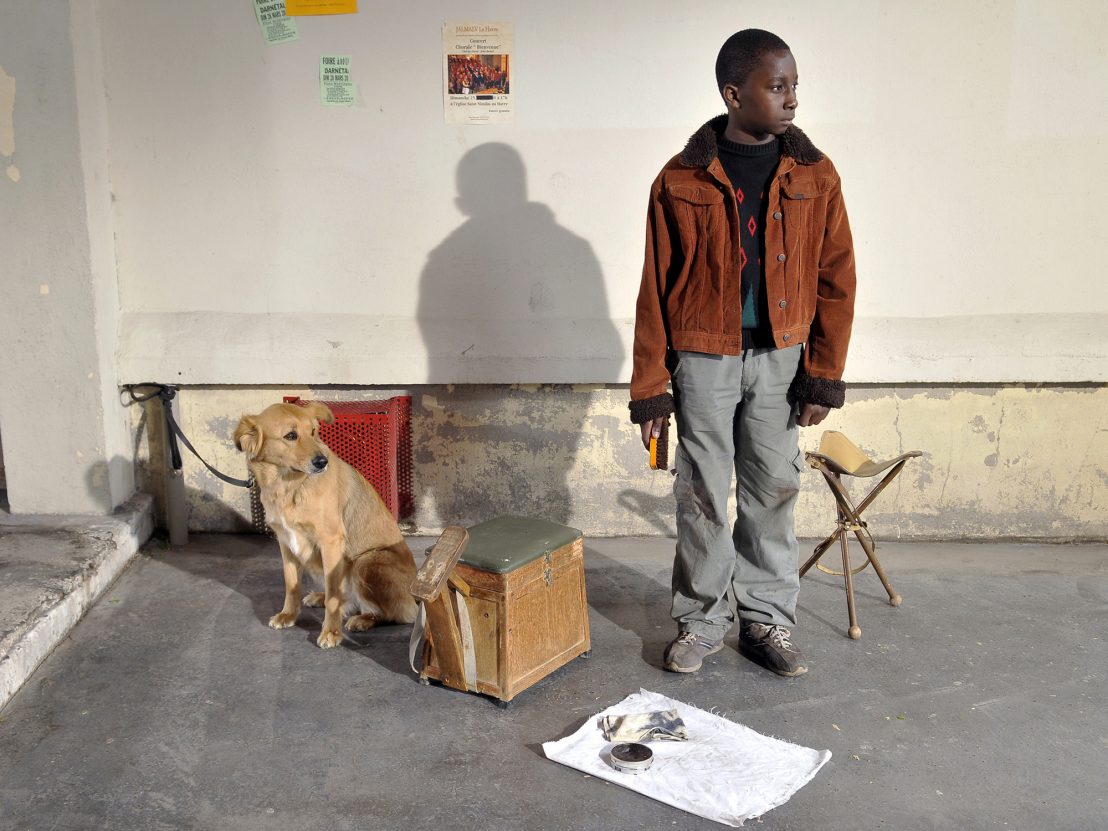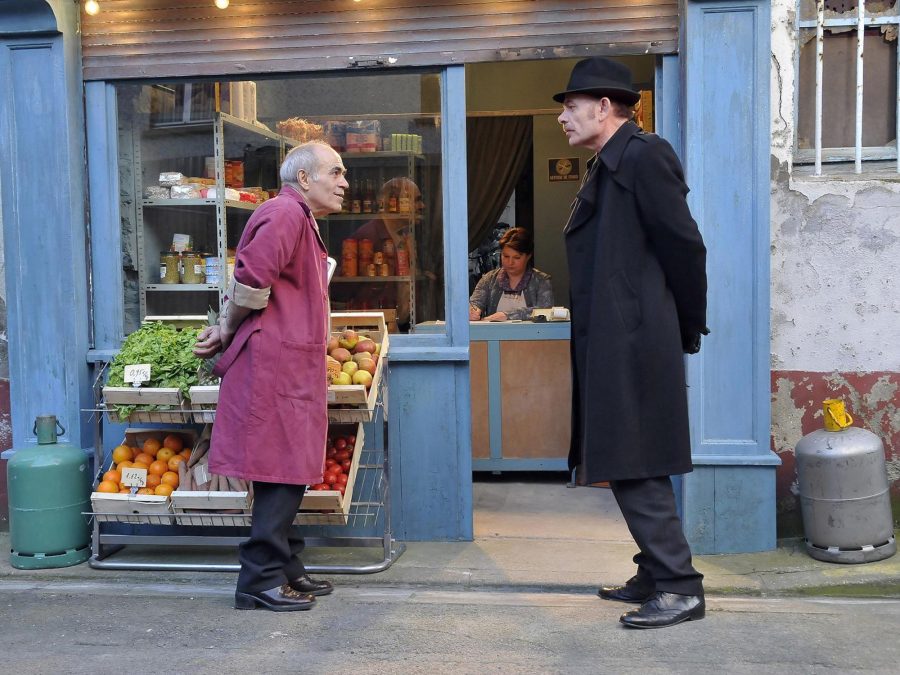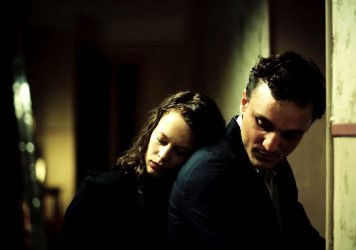
A lot has changed with regards to the refugee and migrant crisis in the 10 years since Le Havre’s UK release. The Jungle at Calais was demolished in 2016. The UK left the EU in 2020. But the perilous journeys of refugees and migrants into Europe and across the Channel have most certainly not stopped – it’s estimated that more than 10,000 have already made the crossing this year.
In Le Havre, director Aki Kaurismäki tells the story of Idrissa (Blondin Miguel) a boy who has been smuggled along with his family in a shipping container from Gabon into the French port town of Le Havre with the ultimate goal of reaching London. The town’s inhabitants are rounded up by Marcel Marx (André Wilms), a boyishly-determined ex-bohemian shoe-shiner, to do everything in their power to hide Idrissa from the authorities.
A film which has a real-life humanitarian crisis at its core might have viewers expecting an unflinching depiction of desperation or to have their heartstrings tugged as forcefully as the cause is urgent. Le Havre takes a different approach.
The film’s characters have their emotions oddly muted and speak with a stilted air; when Marx announces “I’m home”, his wife, Arletty (Kati Outinen), responds matter-of-factly, “I notice that.” Even in moments of tragedy, Kaurismäki sidesteps dramatic extremes for a celebration of a quieter beauty in the details. In one of cinema’s most leisurely falling-ill scenes, Arletty slowly stops slicing onions in the kitchen, has time to set her knife gently aside, and gently lowers her head onto the chopping board. Her head doesn’t so much fall as fall into place, setting up an uneasily tranquil still-life alongside a half-cut onion.
Elsewhere, in as close as Le Havre gets to a tense bust-up, this quietly eccentric composure seems almost to enter the world of silent film, characters pausing with their hands mid-grab, mid-tussle, as if waiting for an intertitle to pop up. Throughout, the slow pace allows each shot to linger for a moment before it ticks over into the next. The stakes of real-world violence are reduced to those of parody or absurdity – the viewer is made to acknowledge that in this reality everything seems once removed, that it is a world carefully constructed.
Kaurismäki’s signature brand of ironic detachment and languorous absurdity might be thought ill-suited to approach the emotional extremes of such a serious emergency as the European migrant crisis. Does it become easier or more difficult for us, as viewers, to connect with his characters, in the way that they showcase impressive empathy for each other, if their own emotions appear intentionally restrained? How is our empathy for their plight affected if we are constantly made aware that we are only watching a film, that we are at a stylised remove?

Kaurismäki, who announced upon the film’s premiere at Cannes in 2011 that he was “not a documentary or political director”, describes Le Havre as a “fairy-tale”. Indeed, the film’s storybook artificiality goes down to its grain. Actors’ faces are lit in the stage realism of a Bruce Gilden portrait, all their wrinkles and asymmetries drawn into relief and yet hazily radiant. Neatly-decorated domestic sets resemble tonally the painted interiors of the Dutch Golden Age: lived-in yet oddly empty. The effect is not only surreal but oddly old-fashioned.
In fact, one of the most thought-provoking aspects of Le Havre’s peculiarly distanced treatment of its subject matter is the film’s skewed temporal setting. As a product of Kaurismäki’s obsessive distaste for filming modern things, the modern reality of the European migrant crisis, of camps at Calais and at Sangatte, plays out as if on a record slightly warped in the film’s unplaceable retro universe of old cars and rotary phones, all shot by Kaurismäki’s usual director of photography, Timo Salminen, on a camera used by Ingmar Bergman.
This uncanny temporal cross-stitching in the fabric of Le Havre’s present means that the reality of the European migrant crisis quickly feels out of place. The all-too-familiar news-story version we all know becomes defamiliarised by its dislocation. In fact, the film’s indeterminate setting, halfway between now and then, between reality and fairytale, allows the question of how best to respond to the migrant crisis to be posed in the abstract. Untangled by specific political considerations of policies stamped today and revoked tomorrow, it becomes a matter purely of human compassion. The film, like many of its characters, feels as if it comes from somewhere else.
Perhaps more than in any of his films prior, Kaurismäki’s intentionally stilted and laconic style of delivery and observation is stopped short of becoming impersonal. The all-important sequence of locked-off shots revealing the faces of those smuggled with Idrissa in the container might seem to give off the uneasily static and artificial composure of school photos, but they remain personal and poignant. In carefully granting each individual or group of individuals their own time and frame, they are perhaps the most powerful shots in the film. You look into their eyes and read their faces.
From this point of view, the entire film seems to revolve around the importance of the individual. Scenes that might seem extraneous and unnecessarily drawn-out (like the cameo in which Little Bob is reconciled with his wife over a gardening-related dispute and then plays a very Lynchian charity gig) aren’t entirely out of place in a film whose structure seems designed to reinforce that every individual and their story matters. As Kaurismäki remarked upon the 2017 release of The Other Side of Hope: “We are all human. And tomorrow it will be you who will be a refugee. Today it’s him. Or her.”
While the film is undoubtedly muted in many regards, it wears these broader-reaching motivations clearly on its sleeves. The migrant crisis is hauntingly ever-present in the narrative, playing throughout in TV news reports. Chang, Marx’s shoe-shining companion, delivers a rare monologue in the film, revealing “I’m not Chang. I’m from Vietnam, not China.” ‘Chang’, we are told, arrived in France twelve years earlier on top of a train and spent eight years paying for his new identity: “I can enjoy social security and vote, if I want to. I support my family. I’m a happy man. But I’m not him.” The film hits the nail on the head, if somewhat squarely.
But a more direct approach might well be necessary. The sentiment, though the film has turned ten years old, remains, unfortunately, relevant. Still today, the “walking dead” embark upon their desperate journeys and still they are discovered in shipping containers or in the backs of lorries or on shores. Still, in all likelihood, as Chang remarks, “the Mediterranean has more birth certificates than fish”. Only last week, the government was ready to deport the first plane of asylum-seekers to Rwanda until it was stopped by a last-minute intervention from the European Court of Human Rights. The refugee crisis is not a problem of the past. The past, as Le Havre makes clear, is never quite finished.
Like many fairy tales, the film’s outlook does not fool itself or its viewers into idealism. Although reviewed upon its release as Kaurismäki’s “most exuberantly optimistic film yet”, Le Havre is not quite a haven, and the film’s ending is ambiguous. Idrissa’s chances remain slim. The determination of Kaurismäki’s characters’ simple scheming does offer, however, a glimmer of hope. Their resolved belief that something can and will be done to protect Idrissa, if only on this stage of his journey, crucially frames the decision to help the boy as an obvious one, an obligation that the entire town can get behind.
The nuances in Kaurismäki’s curious approach make the film’s deceptively flat and storybook presentation of its subject matter appropriately complex – the film as a work of art, first and foremost, allows it to become an effective work of activism. Le Havre’s old-fashioned sensibility doesn’t stop it from being a film made distinctly for today. By imagining a world ever so slightly different to our present, a reality familiarly ours but once removed, its narrative of hopeful action enters the realm not so much of fancy but potential. This could easily happen; we are one step away.
Published 30 Jun 2022

There’s shades of Casablanca in Christian Petzold’s riveting period romance, set in Nazi-occupied France.

By Grace Wang
His latest stand-up special, Homecoming King, articulates what it means to grow up as an outsider.

Max Fleischer, creator of Betty Boop and the rotoscope, was one of the great cartoonists of the 20th century.